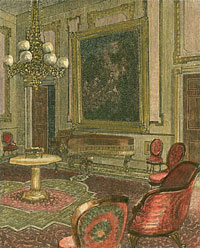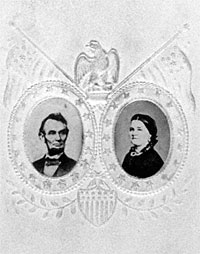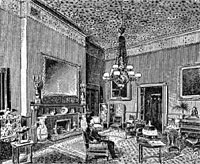There were three public parlors on the first floor of the White House. The Red Room — with a new red carpet installed by Mrs. Lincoln — was used by the President and his wife as the family parlor and a place to entertain close friends, especially after dinner. Mary Todd Lincoln’s historically-minded sister Emilie Todd Helm described it as “the usual drawing room and contains the portrait of Washington which Dolly Madison cut out of the frame to save from the British Dolly Madison’s first husband was a Todd.”1
According to a description of the Red Room by journalist Noah Brooks, “The furniture is very rich — of crimson satin and gold damask, with heavy gilded cornices to the windows and a profusion of ormolu work, vases, etc., some of which stuff is very ancient, being bought or presented during Monroe’s and Madison’s administration. There is a grand piano in this room and a full length portrait of Washington [by Gilbert Stuart].”2 The piano may have been useful since Ward Hill Lamon sometimes gave impromptu vocal concerts in this room for the President.
Shortly after Mr. Lincoln’s Inauguration in March 1861, his family retired to the Red Room at the conclusion of their Sunday lunch. Willie decided to play the piano — causing his mother’s cousin, Elizabeth Grimsley to reprimand him about breaking the holiness of the Sabbath. On one occasion, Mary Lincoln commented to friends gathered here that she hoped her Confederate brothers would be casualties of war. She went on to say that “they would kill my husband if they could, and destroy our Government — the dearest of all things to us.”3
A few weeks later, British journalist William Howard Russell met the President there after accompanying Secretary of State Seward from the nearby State Department. “We accordingly set out through a private door leading to the grounds, and within a few seconds entered the hall of the moderate mansion, White House, which has very much the air of a portion of a bank or public office, being provided with glass doors and heavy chairs and forms. The domestic who was in attendance was dressed like any ordinary citizen, and seemed perfectly indifferent to the high position with whom he conversed, when Mr. Seward asked him, ‘Where is the President?’ Passing through one of the doors on the left, we entered a handsome spacious room, richly and gorgeously furnished, and rejoicing in a kind of demi-jour, which gave increased effect to the gilt chairs and ormolu ornaments.” Russell continued describing Mr. Lincoln’s entrance:
As he advanced through the room, he evidently controlled a desire to shake hands all round with everybody, and smiled good-humouredly till he was suddenly brought up by the staid deportment of Mr. Seward, and by the profound diplomatic bows of the Chevalier Bertinatti. Then, indeed, he suddenly jerked himself back, and stood in front of the two ministers, with his body Mr. Seward formally presented the minister, whereupon the President made a prodigiously violent demonstration of his body in a bow which had almost the effect of a smack in its rapidity and abruptness, and, recovering himself, proceeded to give his utmost attention, whilst the Chevalier, with another bow, read from a paper a long address in presenting the royal letter accrediting him as ‘minister resident’; and when he said that ‘the king desired to give, under your enlightened administration, all possible strength and extent to those sentiments of frank sympathy which do not cease to be exhibited every moment of frank sympathy which do not cease to be exhibited every moment between the two peoples, and whose origin dates back as far as the exertions which have presided over their common destiny as self-governing and free nations,’ the President gave another bow still more violent, as much as to accept the allusion.
The minister forthwith handed his letter to the President, who gave it into the custody of Mr. Seward, and then, dipping his hand into his coat pocket, Mr. Lincoln drew out a sheet of paper, from which he rad his reply, the most remarkable part of which was his doctrine ‘that the United States were bound by duty not to interfere with the differences of foreign governments and countries.’ After some words of compliment, the President shook hands with the minister, who soon afterwards retired, Mr. Seward then took me by the hand and said — ‘Mr. President, allow me to present to you Mr. Russell of the London Times.’ On which Mr. Lincoln put out his hand in a very friendly manner, and said, ‘Mr. Russell, I am very glad to make your acquaintance, and to see you in this country. The London Times is one of the greatest powers in the world — in fact, I don’t know anything which has much more power, — except perhaps the Mississippi. I am glad to know you as its minister.’ Conversation ensued for some minutes, which the President enlivened by two or three peculiar little sallies, and I left agreeably impressed with his shrewdness, humour, and natural sagacity.4
It was in this room that men gathered at the end of President Lincoln’s First State Dinner on March 28, 1861. Having separated the men from the women, President Lincoln had John Nicolay separate the cabinet members into another room where an emergency cabinet meeting was held to discuss the threat to Fort Sumter. He revealed — to the consternation of those present — that General-in-Chief Winfield Scott had urged that both Fort Pickens and Fort Sumter be abandoned. Postmaster General Montgomery Blair, who favored aid to Fort Sumter, blamed Scott’s advice on Secretary of State William H. Seward, who opposed such aid and who had a close relationship with General Scott. That night, “Lincoln’s eyes did not close in sleep,” according to Secretaries Hay and John Nicolay.5 The next day, President Lincoln took the unusual step of asking cabinet members for their written advice on both forts.
Several months later on September 10, 1861 Jessie Benton Frémont, wife of General John C. Frémont, met President Lincoln here at midnight to press the case for her husband’s continued generalship in Missouri. Mrs. Frémont later recalled: “After some little waiting the President came in from [the State Dining Room] by the farther door, leaving the door partly open. As he crossed the room that door was still more widely set open. I introduced Judge [Edward] Coles, who then stepped into the deep doorway leading to the blue room – we were just by it – and there he remained walking to and fro, keeping in sight and hearing, just within the range of the doorway. For he was struck at once, as I was, by the President’s manner, which was hard – and the first tones of his voice were repelling. Nor did he offer me a seat. He talked sanding, and both voice and manner made the impression that I was to be got rid of briefly.”6
President Lincoln could be courtly. He could also be curt. “You are quite the female politician,” President Lincoln told Jesse Frémont. The President’s temper, which could be kept in check when dealing with the most obstreperous generals, was ignited by her persistence in defending Gen. Frémont against charges of usurpation of authority and mishandling of Union forces in Missouri. Mr. Lincoln had already had a long day, reviewing troops outside of Washington.7
Mrs. Frémont not only delivered a letter from her husband about military developments, but attempted to argue at length the political reasons for his order emancipating slaves in his theater of the Civil War. The President later told John Hay: “She sought an audience with me at midnight and taxed me so violently with many things that I had to exercise all the awkward tact I have to avoid quarreling with her. She surprised me by asking why their enemy, [Postmaster General Montgomery Blair] had been sent to Missouri? She more than once intimated that if Gen. Frémont should conclude to try conclusions with me he could set up for himself.”8
The Red Room was not usually part of the public rooms used during levees so furniture from the East Room and Blue Room was temporarily stored in the Red Room. It was also in the Red Room where spiritualists conducted a notable seance for Mrs. Lincoln. Most seances for Mary Lincoln were conducted outside the White at the homes of friends, but occasionally the mediums came to the Lincolns’ home. Nettie Colburn Maynard reportedly conducted one such encounter with the spirit world in the Red Room. It could also be used for other kinds of informal entertainment — such a presentation by humorist Stephen Masset in June 1864.
It probably was in this room that singer Madame Patti came to visit with and sing for the Lincolns. She said later that “we were received by Mrs. Lincoln in one of the big parlors. The President’s wife was a handsome woman, almost regal in her deep black and expansive crinoline, only an outline of white at throat and wrists. Her manner was most gracious without a particle of reserve or stiffness. ‘My dear, it is very kind of you to come to see us,’ she said. Taking both my hands in hers and smiling in my face, she added,’I have wanted to see you; — to see the young girl who has done so much, who has set the whole world talking of her wonderful singing.'” After several songs, Madame Patti accompanied herself on the piano while singing, ‘The Last Rose of Summer.’ She realized afterwards that she had “made an awkward choice.’ Mary has “risen from her seat and was standing at a window in the back part of the room with her back toward me. I could not see her face but I knew she was weeping.” Mr. Lincoln then requested ‘Home Sweet Home.”9
Historian David Rankin Barbee wrote that her accompanist “did not know the air, and Patti, who knew it, did not know the words, and had never sung them. Seeing her dilemma, ‘the President rose from his seat, went quickly to a small stand at the foot of the piano, took from it a small music book, with a vivid green color, and placed it on the piano rack, opened to the music of Home, Sweet Home. Then he returned to his seat without a word and resumed his former posture. ‘Well, I sang the song the very best I could do it,’ Patti concluded,’and when Mr. Lincoln thanked me his voice was husky and his eyes were full of tears. By that time I was so wrought up over the situation myself that I was actually blubbering when we were taking leave of the recently bereaved parents.'”10
It was probably in this room in February 1865 that Mr. Lincoln told Colonel James Grant Wilson the story about an old Southern Illinois politician who had approached him in 1860: “So you’re Abe Lincoln,” said the Democrat.” “Yes, that is my name,” said Mr. Lincoln. “They say you’re a self-made man,” said the Democrat. “Well, yes, what there is of me is self-made,” said Mr. Lincoln. “Well all I have got to say is that it was a damn bad job,” said the Democrat.11
Lincoln aide William O. Stoddard later recalled: “The Red Room does not look unpleasantly red by gas-light, but the prevailing tint has its effect upon any and all other tints exposed to its influence. For instance, it heightens the deep crimson shade of the silk that Mrs. Lincoln is wearing this evening, and makes it contrast more decidedly with the simple blue worn by the slender young woman who is here to assist her. When good Mrs. [Mary Jane] Welles come in – for she is to come, with a party of friends from the North – there will be more and very capable assistance; but there will also be another and even stronger contrast, for she always wears sober colors.”12
President and Mrs. Lincoln were in this room with friends when he received word that General Lee had surrendered at Appomattox on April 9, 1865. It was in this room that the President met with Congressmen George Ashmun and Schuyler Colfax just before he went to Ford’s Theater on April 14, 1865. They discussed Speaker Colfax’s impending trip to California. “Don’t forget, Colfax, tell those miners that that is my speech to them [that western resources should be quickly developed], which I send by you. Let me hear from you on the road, and I will telegraph you at San Francisco. Pleasant journey and good bye.” Earlier, Mr. Lincoln had told Colfax to tell the miners “that I shall promote their interests to the utmost of my ability; because their prosperity is the prosperity of the Nation…[and] we shall prove in a very few years that we are indeed the Treasury of the World.”13 Doorkeeper Tom Pendel in Thirty-Six Years in the White House recalled:
On the fourteenth of April, 1865, in the evening just previous to the time when the President and Mrs. Lincoln were going to the theatre, George Ashmun, of Massachusetts, called on Mrs. Lincoln, and I showed him into the Red Parlor, took his card upstairs, and soon the President and Mrs. Lincoln, with Mr. Colfax, then Speaker of the house, came downstairs and went into the Red Parlor where Mr. Ashmun was waiting. They all entered into a lively local conversation, and came out of the Red Parlor presently, and stood in the inner corridor. Their conversation was about the trip Mr. Colfax proposed to take across the continent. They then passed out of the corridor into the main vestibule. Mr. Colfax bade the President and Mrs. Lincoln good-evening, and went upstairs to see the Private Secretary, Mr. John G. Nicolay. Mr. Ashmun went out on the portico with the President and Mrs. Lincoln, said good-bye and started off downtown. Ned Burke and Charles Forbes, the coachman and footman, respectively, drove over to a private residence, and took in the coach Major Rathbone and Miss Harris, who was the daughter of Senator Ira T. Harris, of New York.14
Footnotes
- Katherine Helm, Mary, Wife of Lincoln, p. 222
- Michael Burlingame, editor, Lincoln Observed: Civil War Dispatches of Noah Brooks, p. 81.
- Ruth Painter Randall, Mary Lincoln: Biography of a Marriage, pp. 263-264.
- Fletcher Pratt, editor, William Howard Russell, My Diary North and South, p. 22-24.
- Carl Sandburg, Abraham Lincoln: The Prairie Years and the War Years, p. 224-225.
- Allan Nevins, Frémont: Pathmarker of the West, p. 516-617.
- Allan Nevins, War for the Union, Volume I, pp. 426-428.
- Michael Burlingame and John R. Turner Ettlinger, editors, Inside Lincoln’s White House: The complete Civil War Diary of John Hay, p. 123.
- Katherine Helm, Mary, Wife of Lincoln, p. 200.
- David Rankin Barbee, “The Musical Mr. Lincoln,” The Abraham Lincoln Quarterly, December 1949, Vol. V., No.8, pp. 437-439, (from an interview in the
- Montgomery Advertiser, February 12, 1911.)
- Rufus Rockwell Wilson, Intimate Memories of Lincoln, p. 427.
- William O. Stoddard, Inside the White House in War Times, pp. 174-175 13. Willard H. Smith, Schuyler Colfax, p. 207.
- Thomas Pendel, Thirty-Six Years in the White House, pp. 39-40.
Visit
Winfield Scott
Mary’s Charlatans
Schuyler Colfax
Elizabeth Todd Grimsley
William H. Seward
Abraham Lincoln and Music
William Howard Russell










